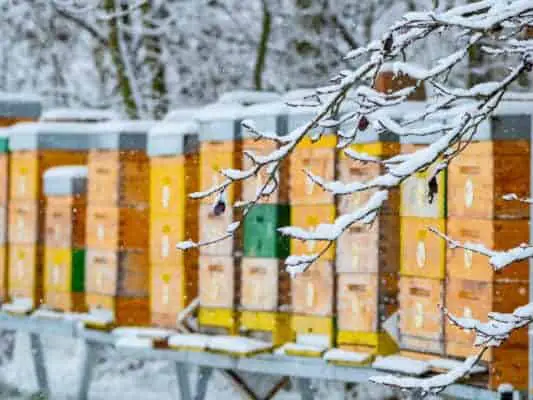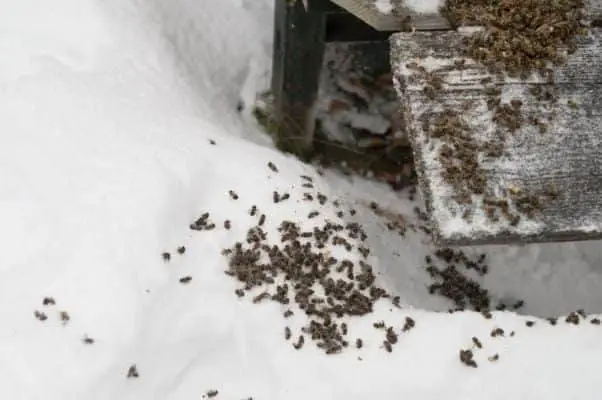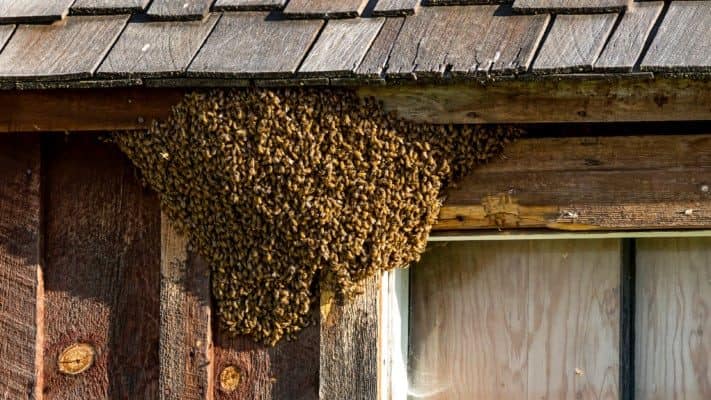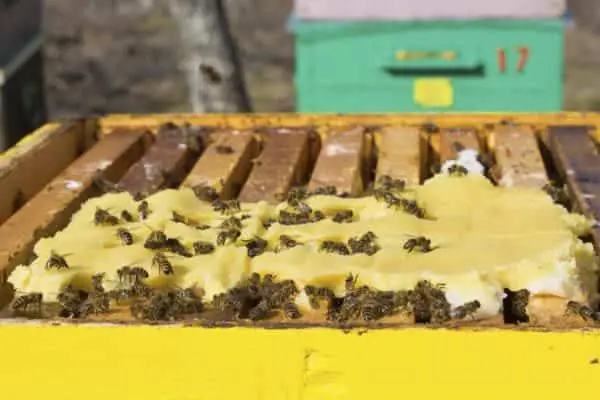All living beings, including humans, have unique ways to cope with the cold winter season. Some animals like bears hibernate while some birds migrate.
Humans are not that different than bears in that manner, as during winter they would bundle up, rush through the everyday outdoor chores, and get back into their warm cozy houses.
But what about the buzzing, bumbling, always busy insect? What happens to bees in winter? Do they hibernate, die, or migrate?
Given their role in pollination, it is essential to know their behavior. Well, while they may look tiny, vulnerable, and far too delicate to withstand the winter, these little creatures are more organized than one may think.
Honey bees don’t migrate nor hibernate in the winter. Although, when temperatures drop below 570 F, they remain in the hive forming a winter cluster, with the queen at the center. Worker bees vibrate their bodies generating heat, keeping the hive at about 950F. Stored honey provides energy in the winter.

This phenomenon is not the case for all bees species, though. Just like wasps, some bee species hibernate during winter, and mostly only the queen survives the freezing cold.
Do the bees reproduce during the cold season? What happens when we take their honey reserves? Why do honey bees swarm?
Stick around as we dig deeper into how these fascinating creatures survive the cold season.
What Is Migration And Why Do Animals Do it?
Migration is the seasonal movement of animals from one region to the other. The distances may range from a few miles to thousands of miles. This behavior is common in mammals, birds, fish, reptiles, amphibians, and even insects.
There are many reasons for migration, which include the climate, season of the year, availability of food, or for breeding. Sometimes animals migrate to get a place to hibernate.
Examples of Migration
- Annual wild beast migration for seasonal grazing.
- Birds migrating into the southern hemisphere to escape the winter season.
- Crustaceans and amphibians migrating to breed.
- Locusts migrating to find food sources and causing natural disasters as they go.
- Butterflies migrating to establish new colonies and in search of food sources.
- Whales migrating in winter to areas with food such as the Northwestern coast of Africa.
Scientists are yet to find out how these creatures figure out where they are going. It is believed that some animals use landmarks like streams or rivers. Others navigate using the position of the sun and the stars, while others use the sense of smell to find their way. There are still some species that use the Earth’s magnetic field to navigate through.
How Honey Bees Escape The Winter
It’s even redundant to say that honey bees are super intelligent. Being aware that the cold winter season is around the corner, busy bees stock as much honey as possible during summer.
It’s super common to see bees collecting nectar and pollen in the warm months. When the cold season kicks in, they retreat in the hives. Their primary role now is to take care of the queen; keep her safe and warm. The female worker bees surround the queen and the brood and form a cluster. They keep their heads pointed on the inside of the bee cluster.
The bees continuously flutter their wings and shiver (vibrate with their flight muscles) to maintain the warmth. This constant movement and continual energy use maintain a temperature of about 95 0F within the cluster.
The workers rotate from the outside and inside of the cluster periodically throughout so that none of the bees will get too cold. Talk about teamwork! On the warmer days, the workers go out of the hive to relieve themselves (cleansing flights) and also clean up the beehive.
The bees get through the winter season without fresh pollen, although there is no new brood being raised at this time. In the late fall and early winter, the queen bee ceases to lay eggs since the new bees would demand a special diet and the main goal is to preserve the limited food.
She starts laying eggs again towards the end of the winter. The bee bread made has a shelf life in the hive of a couple of months, while honey can be stored for years. The bee pollen stored for a long period dries out and loses most of its nutrition value.
If a colony depletes its food reserve, it can freeze to death before the spring season. This cold season is not for the lazy-bones either; the unproductive drones are driven out of the hive to preserve the food supply.
Although worker bees have a lifespan of five to six weeks, they can survive for more than five months during winter. This longevity is because they are less active, and they focus their energy on survival.
If the winter season is long, a colony may not have the reserves to wait for the spring pollen. In this case, the beekeepers may feed the colony with pollen supplements in the early spring.
If you are interested, we have another article that we go into more detail about, How bees survive the winter.
How Do Bees Maintain The Warmth In The Hive?
Proper temperature regulation in the hive is vital for the colony’s survival in winter. Honey bees are fascinating creatures! As the ambient temperature rises, the bees on the outside of the cluster separate a bit.
This allows the air to flow around. As the temperatures fall, the bees pull closer together. When the bees on the outside of the cluster get cold, they push towards the center.
Unlike some insects, bees are usually active throughout winter. If the bees get too cold, they freeze and can’t even move to their food sources. A strong and populous colony is essential to maintain warmth in the hive.
If the bees are not enough to maintain the heat, the colony may not survive the winter season. Freezing is one of the reasons why many beekeepers lose their bee colonies in the winter.
At What Temperature Do Bees Die?
A beehive temperature needs to be just right for the bees to survive. If it gets too high, the brood dies, and the honey gets dehydrated too fast. If a beehive gets too cold, the brood freezes and dies off.
Bees forage when the temperature outside is above 570F. If their body temperature falls below 450F, their muscles freeze up, and they die. They are unable to operate or flex their shivering muscles to stay warm.

The bees work to maintain the temperatures at (910F-950F) in their hives. That is why, in the winter, they cluster together to generate heat.
Should A Beekeeper Harvest The Honey?
This sounds like a real thinker, considering that now we know that the honey we take from the hives is meant for the bees to survive the winter season. However, you can relax as there is good news in all of this.
Honey bees produce more than they consume during the winter season. They generate about two to three times more honey than they need. Beekeepers harvest the extra honey.
Nevertheless, it is still advisable to be on the lookout not to take everything. There should be enough reserves left for the cold season.
How Can Beekeepers Help The Bees To Survive The Winter?
There are various ways a beekeeper can help honey bees colonies to pull through the winter season. Some of these include supplementary feeding, pest and disease control, removing the queen excluder, and so on.
Before the winter, it is advisable to sample your hives for varroa mites. If necessary, treat the colonies since infested bees may not pull through the winter.
This also applies to the American Foul Brood Disease.
The Behavior Of Other Common Bees Species During Winter
Carpenter Bees
Carpenter bees are famed for being a nuisance. They drill into woods to make their nests and do not live in colonies like honey bees.
Once a carpenter bee finds a mate, they stick together in the summer and spring seasons. The females lay eggs in the drilled galleries, gather enough food for the offspring, and die shortly after this. Some adults may survive in nest tunnels. The eggs hatch in early fall.
During winter, the young carpenter bees that hatched hibernate in their nests, and at the onset of spring, they emerge to start a new life. The cycle continues like that. The bees that survive the winter emerge in spring to feed, mate, lay eggs, drill nests, and stock food for the young ones.
Bumblebees
Bumblebees hibernate during winter. Unlike honey bees, their colonies are short-lived, lasting only for a few months. At the end of the cycle, the queen bee hibernates in a small underground nest and emerge in the spring season to start a new colony. She produces glycerol, a chemical that keeps her from freezing as the temperatures get colder.
At the beginning of spring, she searches for a site to use as a nest, lays eggs, and forage for nectar and pollen.
After the first batch of young ones is hatched, the new workers take up the tasks of foraging, nest building, and taking care of the young ones. The queen is left with the role of laying eggs only.
In late summer, the queen begins to produce virgin queens and males, who move out of the nest to mate with bees from other colonies. During winter, the mated queens will hibernate while the rest of the bee colony, together with the old queen dies. The queens emerge again in spring to start their new colonies.
We have another related article you might be interested in, Carpenter Bees Vs Bumblebees Vs Honey Bees.
Mason Bees
Solitary and very hardworking, mason bees are only active for around 8-10 weeks in the spring. This season is usually the best time for pollination of fruit trees and berries.
Most mason bee species are well adapted to cold winters. The bees hibernate for about 10 months and emerge in the pollination season (mid-March to early June). Young bees overwinter as hibernating adults in their cocoons.
What Are Bee Swarms?
Swarming in a honey bee colony is a part of their natural reproduction life cycle. It is the recreation of a new bee colony and is crucial for their survival.
Most colonies swarm during spring when the weather is conducive, and pollen and nectar are abundant. Sometimes, swarming can also happen in the fall and summer. Honey bee swarming takes place when the hive becomes too crowded and therefore subdivides into two groups.
When a hive is overpopulated, food will be scarce, and the colony’s health will deteriorate. One group departs while the other is left in the existing beehive.
Bees can also abscond. Absconding is a process whereby all bees, including the queen, leave an existing beehive rather than split. It may be due to food scarcity, disturbance by animals or humans, parasite or disease infestation, poor ventilation, weather changes, and so on.
Swarming Preparations
The worker bees detect the ideal time to swarm due to overcrowding. They deprive the queen of food supply so that she can slim down and be light enough to fly easily. They also perturb her and run her around so as not to lay many eggs.
The workers permit the queen to lay eggs in the queen cups so that a new queen will come forth and take over the hive. They feed the chosen larva with royal jelly, and before a new queen emerges, the swarm leaves the beehive.
Most swarms leave a colony between 10 am and 2 pm on a warm sunny day. A bee swarm may contain hundreds to several thousands of worker bees, a queen, and a few drones.
Scout bees find a nearby location for the bee swarm to cluster on while they find a new home. The bees may cluster on a tree or a branch just near their old hive. Once the scout bees find a new location for the colony, the bees will guide their queen and get her settled.

A cluster can stay from a few hours to a few days, depending on the time the scouting bees take to get a new home. The workers then start building honeycombs and resume their foraging duties. The spring season is the ideal time to swarm since there is plenty of time to establish a colony and store food reserves for the cold season.
Back in the original hive, the first queen to emerge from her queen cup will hunt down all her sisters to ensure she is the only one standing. The forager bees take care of the new queen and raise young ones to rebuild the colony before winter.
There are a number of situations where beehives could have two queens. We have written an article where we take a detailed look at why there could be more than one queen bee. The article is called, Can A Beehive Have Two Queens? Who Rules Then?
Should You Fear Bee Swarms? Are They Dangerous?
It can be shocking to encounter a swarm of bees. Amazingly, they are not aggressive at this stage; however, they can attack if provoked. The bees are less hostile since they don’t have brood or young ones to defend.
Swarming honey bees also feed before they start their journey, which reduces their ability to sting. Some beekeepers capture the swarms and move them to appropriate locations before they choose a new home. It can be an ideal source of bees when planning to establish a new hive.
If a bee swarm chooses to settle on your building, you should stay indoors for half an hour or so until the flying bees settle on a bush or another object. Once they have formed a cluster, you can go on with your usual activities. Be sure to put your shoes on just in case the older bees have settled on the ground.
Wondering what to do if you see a swarm of bees? Check out this article we have written called, Bee Removal. How It’s Done and Who Can Do It For You.
The Wrap Up
Just like human beings, there is so much diversity with bees that we should celebrate. Although in many bee species, only the queen survives the winter, honey bees remain active despite the freezing temperature and zero foraging.
In the winter season, that is when they enjoy the fruits of their hard work by feeding on the honey they made in the productive months.
A beekeeper should ensure the bees have enough food reserves for the winter months since once they deplete their stored honey, they can starve to death.
Sources
https://www.kelleybees.com/blog/news-events/how-do-hone
https://www.britannica.com/story/where-do-honeybees-go-in-the-wintery-bees-survive-the-winter/
https://www.thoughtco.com/how-honey-bees-keep-warm-winter-1968101
https://en.wikipedia.org/wiki/Swarming_(honey_bee)
https://ucanr.edu/blogs/blogcore/postdetail.cfm?postnum=30352
https://www.agric.wa.gov.au/pest-insects/bee-swarms
https://scienceblogs.com/lifelines/2011/07/19/cunning-cuttlefish
https://www.ehow.com/info_12283704_freezing-temperatures-kill-bees.html

